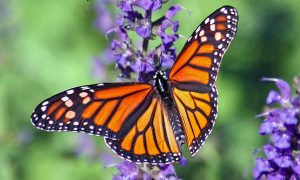
Given the amount of greens they consume in their youth, you would think butterflies would be more muscular. How can a diet of brassicas produce both Arnie and these feather-light sylphs that flit like ashes on the summer breeze?
This time last year, butterfly numbers were found to be on the up, following an all-time low in 2022. How do we know? Because people counted them. The Big Butterfly Count involves tens of thousands of participants counting butterflies and submitting their results to Butterfly Conservation, who keep a watchful eye on these things. You choose a spot, sit there for 15 minutes (or you can stand if you like) and make a note of all the butterflies you see.
I sat in my vegetable patch and counted 15, including two Red Admirals, which I thought was a good sign until I read that they’re proliferating due to climate change. There was a Common Blue, which is in decline, and the rest were Large Whites, which are doing very well thank you, and I know why. They’ve discovered my broccoli.
I’ve always shied away from growing brassicas because even if you get a good head of cauliflower or a nice looking cabbage, you can bet your life it’ll be full of caterpillars when you cut it open. But they look good. They make a vegetable patch look like it’s doing well, and so this year I ignored my own advice and planted three varieties of broccoli.
It began well. I got some very tender and tasty calabrese. Meanwhile, the later sprouting varieties were growing vigorously and didn’t seem to be attracting any interest from whatever demon it was that kept breaking in and devouring my runner beans seedlings.
But then this week I went to water the broccoli and the whole thriving plot had been reduced to a skeleton, the leaves stripped to the bone, a wasteland of ghostly rows of latticed emptiness, like the ruins of a sacked cathedral. There were caterpillars everywhere, huge, muscular beasts, posing for one another with flexed biceps and pulsing pecs, their bellies gorged and groaning.
Caterpillars grow so fast that their skin splits four or five times in the handful of weeks from the day they hatch to the day they go into their chrysalis. Imagine that! Eating so much that your skin splits. And then doing it again! But they need to do it because the butterfly that emerges lives largely on the food it consumed as a larva. They only stick around for a couple of weeks, which seems a shame after all that effort, although some do hibernate and will live for several months to lay their eggs on my broccoli in spring.
So why the name butterfly? Are they partial to butter on their greens? Is it the way they butt into windows when they can’t find their way out? Unlikely. The original Anglo-Saxon ‘buterfleoge’ was coined before we had glass windows. The best guess is that one of the most common butterflies in England is the Brimstone, which can live for a year in its adult form and is yellow, a bit like butter is. Another guess is that it’s a spoonerism of flutter-by.
However the butterfly got its name, it’s been generous in giving it away: a swimming stroke, a stitch, a clip, a showy person, a nervous flutter in the stomach… Butterflies are a joyous, dainty and colourful sight on a summer’s day and an indicator of the health of our environment. We need to conserve them. But they need to have a word with their kids.


